Sarees usually carry the name of their origin, and the places where silk sarees are woven are indeed many in India! At other times the sarees are given names usually descriptive of their weave or appearance. Each state has its time-tested traditions of sarees, carrying names in the vernacular, sometimes varying from village to village. This glossary is limited to introducing the more popular handwoven silk sarees.
Armoor Sarees
Heavy silk sarees from Armoor in Andhra Pradesh with rich pallus created with the extra weft, giving a brocaded look. Many are in imitation of Maharashtrian brocades. Now not so commonly woven.
Ashavali Sarees
Ashavali sarees are from the city of Ahmedabad in Gujarat. They have rich brocaded patterns woven in a twill weave. In a rich background of zari, many coloured yarns are introduced to create wonderful enamel-inlay-like (Minakari) designs of birds, flowers, animals and figures. This elaborate and time-consuming technique was reserved for only border and pallu in later times. Though not so commonly woven these days, the tradition continues in a small way in Ahmedabad and Gandhinagar in Gujarat by a few dedicated weavers. And many display the original sumptuousness of the noble Ashavali of the early days.
Baluchari
In the 14th and 15th centuries, weavers from Varanasi migrated and settled in Baluchar, a village near Jiaghanj in the Murshidabad district in Bengal. Char means ‘delta created by silt’. They wove beautiful mulberry silk sarees that were famed for their pictorial borders and pallu, wherein figures of lords and ladies, scenes from the Ramayana and the Mahabharata epics, Krishna’s playful tricks or dalliance with Radha and other such narrative motifs were woven brocade-style with extra weft yarn. Sometimes these were even topical, showing motor cars, trains, and western-style carriages. They are similar to brocades, but zari is never used, the beautiful patterns being created with only extra weft silk yarn. At one time, the brocade weave was only in lustrous white silk, giving the patterns a pearly sheen. As with other traditions, they died with the British imports and power looms. But in 1958, the Baluchari was revived in Bishnupur in West Bengal (the original village of Baluchar was washed away by the Ganges) and now enjoys sustained popularity.
Berhampur
I figured Tussar or mulberry silk sarees from Berhampur in Orissa. They have extra weft work in their borders. They often have interlocked weft in the traditional Kumbha (auspicious pot of plenty) or the ‘temple’ design of serrated triangles resembling temple towers. Traditionally they have very large pallus (headpieces) and many bands of different weft patterns in border and pallu. They are heavier silks and are often called Berhampuri Pattu (silk).
Bomkai
Traditional Orissa sarees from the village of the same name. They were woven in cotton, but now silk Bomkai is increasingly popular. It has no ikat work. The body is often plain and traditionally in red, white or black. But attention is on the many lines of patterns on the border and pallu. The pallu’s interesting feature: extra weft threads create the designs, mainly geometric, of lines and single motifs. The warp threads of the body (field of saree) are cut and joined to the contrasting warp threads of the pallu. This joining point can be in the form of large triangular patterns on the pallu or elaborate geometrical designs.
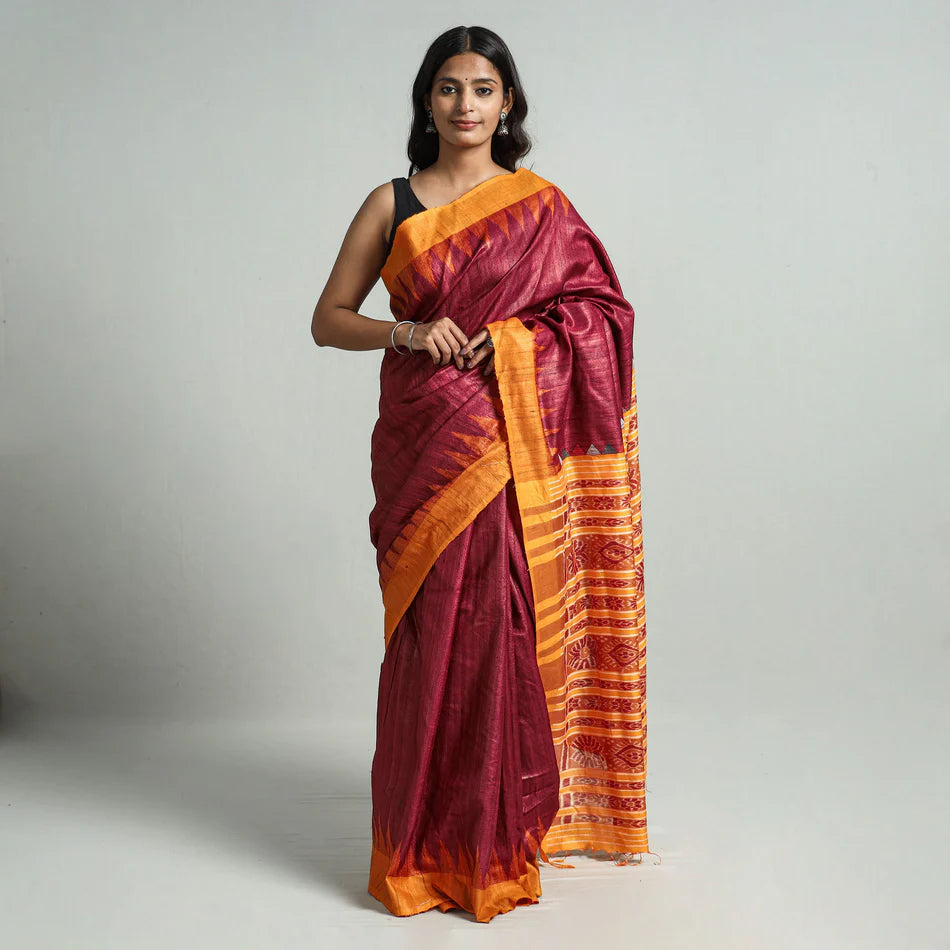
Butidar Sarees
Silk sarees with hundreds of butis woven throughout the saree. These are usually of zari but are also produced with silk yarn motifs. When woven in a dark colour, they give the impression of a starry night.
Dharmavaram Sarees
Dharmavaram sarees are the exclusive patronage of the town of Dharmavaram in the Anantapur district of Andhra Pradesh. Sarees are traditionally woven in the interlocked-weft technique. These sarees have broad borders with solid colours and contrasting pallus woven with intricate golden zari brocade. Dharmavaram saris comprise heavy ‘pallus’ with exclusive designs. Dharmavaram silk sarees are the most attractive and desired wedding sarees. Though the Dharmavaram sarees are similar to the Kanchipuram sarees of Tamilnadu, the muted colours and the double shades create a different effect.
Kanchipuram
The pride of silk sarees of Tamil Nadu. The Kanchipuram, or Kanchi, is woven in the temple city of Kanchipuram near Chennai. It is characterised by being woven with the murukku-pattu yarn — twisted yarn, to produce heavier weft and warp yams. The same coloured pallu matches the brilliant contrast borders with zari or silk thread.
The borders are interlocked with the body in the korvai technique, and the pallu is woven by laying the contrasting warp (of the pallu) next to each warp of the body by the laborious method of the pethni, perfected in Kanchipuram. Kanchipuram with lotus motifs Glorious colours of contrast characterise the Kanchipuram.
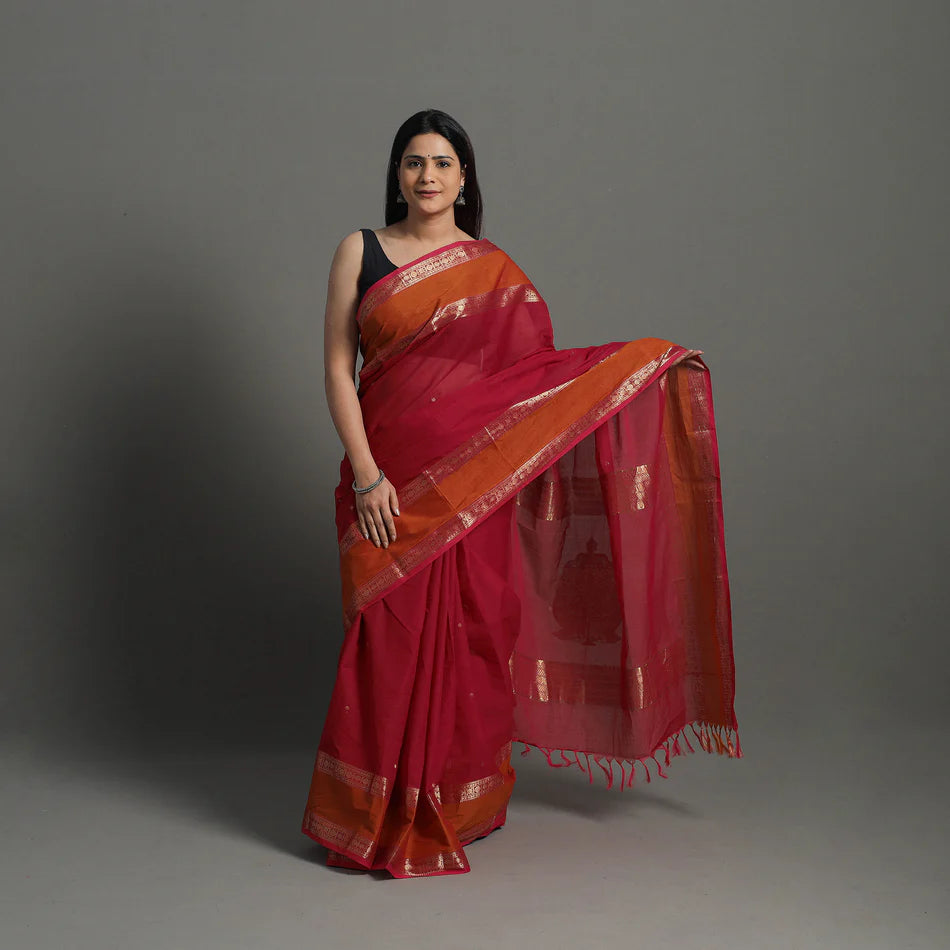
Kantha Sarees
Tussar or mulberry silk sarees embroidered with a simple running stitch. This stitch was traditionally used on quilts, called Kantha in Bengal and sujani in Bihar, made from old sarees to keep the layers together. They were worked on communally by the women of the villages. But now elaborate patterns of birds, flowers, animals, lines, geometric forms, and stick human figures are created on sarees from West Bengal and Bihar.

Kodiyal or Gorad Sarees
West Bengal. “Gorad” (or Gaurad) means white. They are also called Puja sarees as they are used on ceremonious occasions. These are woven from undyed white Tussar or twisted spun mulberry silk with a simple single-colour block border. Small geometric or paisley motifs in the same border colour are strewn throughout the body sometimes. The pallu reflects this simplicity, composed of lines and a few motifs.
Gadwal
From Gadwal, a town about 150 km from Hyderabad, the capital of Andhra Pradesh. These have traditionally been a field of fine cotton with an interlocked silk border. Some carry zari butis on the body and elaborate zari heavily patterned pallu. Tissue versions are created with cotton warp and zari weft, as in other silk tissue traditions.
Gharchola
Tie-and-dye wedding saree from Gujarat, in red or green patterns of big squares numbering multiples of 9, 12, or 52. It is further embellished with woven zari lines along the squares. Sometimes, in addition to the bandhani work, delicate zari embroidery for a more luxurious look for weddings. Traditionally these were woven in cotton as they were worn casually {gharchola means house dress). But now it has evolved into being woven in silk, crepe silk and georgette.
Ilkal (Irkal) Sarees
Silk sarees from Karnataka as well as southern Maharashtra. Weaving has been done in Ilkal in the Bellary district since the 8th century. Traditionally these carry pallus in red silk with Kasuti embroidery, though now other colours are used. See Kasuti Embroidery. They have characteristic white silk yam bands in the pallu. Ilkal sarees can come in silk cotton as well. They have distinct contrast borders, often in a mayilkan (peacock’s eyes) pattern in red and golden yellow.

Jamdani
Jamdanis are traditionally muslins, legendary in their lightness and exquisite patterning, produced in Dacca (Bangladesh). The brocade was created with extra weft in cotton yarn. The silk jamdani is fine silk brocaded with fine cotton or silk. Patterns are made with supplementary weft in an inlaid fashion but without floating yarn on the reverse. Whereas traditional muslin jamdanis had only white or off-white designs, silk jamdanis now display delicate coloured patterns.
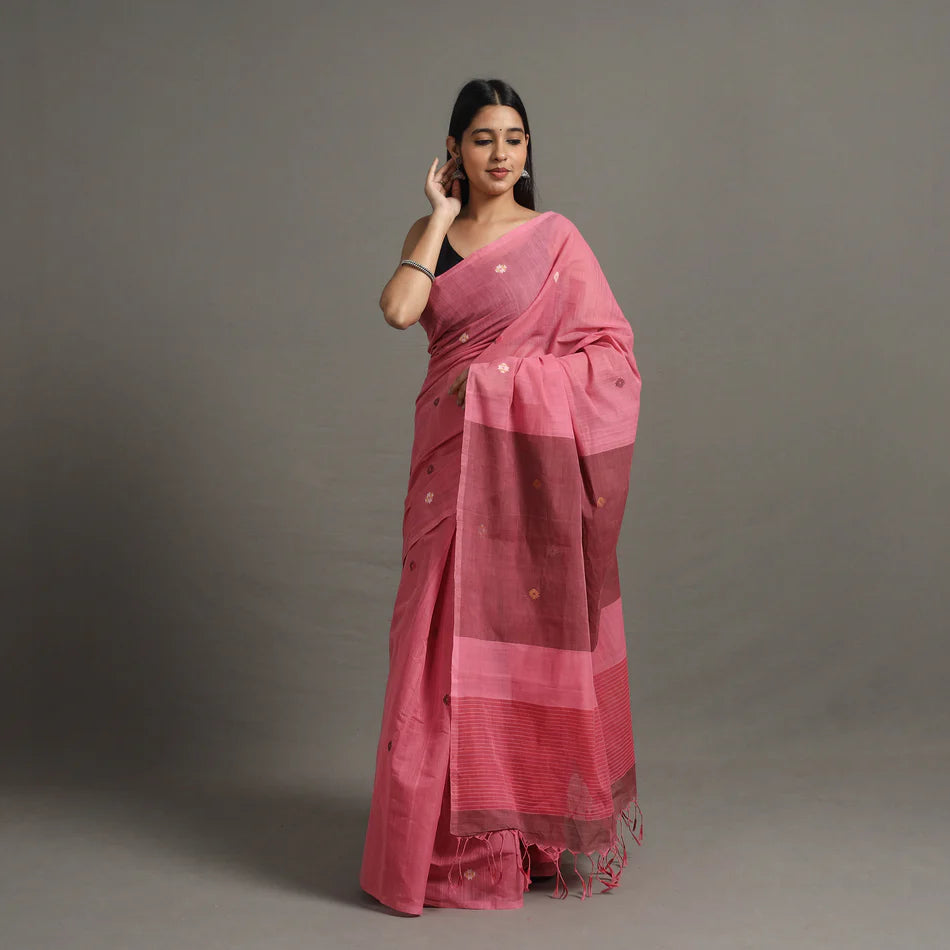
Kerial
Handloom silk saree from West Bengal from twisted de-gummed silk yarn with plain contrast border and pallu.
Kornad
Sarees from Tamil Nadu. While Kornadu does not produce these sarees much today, they can come from Thanjavur, Kumbakonam, Madurai, Arni, Salem or Kanchipuram. People identify Kornadu silks to be typical of south Indian sarees. These have contrast borders varying from 4 inches to twelve inches and a pallu of the same colour as the borders, with simple line patterns woven usually in the saree's body (field) colour. Traditionally the borders were not ornate, having at the most a line or two along the length. The body could be checked or stripped. Though Kornadu is a small town near Thanjavur, it is a common name given to these sarees with contrasting borders from the state. Nowadays, Kornadu sarees are also woven in cotton and silk in Karnataka.
Paithani Sarees
Though these sarees are woven elsewhere, Paithan in Maharashtra has been immortalised in the saree which bears its name. It is a rich tapestry weave with a brilliant sheen of zari on the borders and pallu. Motifs of peacocks, parrots, lotuses and flowers are woven in multicoloured silk yarn, creating brilliant enamel-like effects. The weft shuttle is not thrown across the warp like a traditional weave. On a zari warp, many colours of silk thread are used in an interlocking method, like a tapestry. The effect is a dazzling combination of shimmering gold with geometrical, oblique motifs of swans and birds, peacocks and trees, and stylised flowers and vines in many coloured threads. Paithanis have maintained the traditional weave in border and pallu while opting for a rich silk body with butis strewn throughout the saree.

Patola
Patolas are woven in Patan in Gujarat. Hence its name. These are “Double Ikat” sarees where both warp and weft yams are tie-and-dyed first before weaving. Thus it requires masterfulness, preferably in the dyeing to match up warp and weft to create the design and secondly in the weaving to produce the pattern meticulously. Popular Patola designs are paan Bhat (pipal leaf design), chhabad (basket), kunjar bhat (parrot design), narikunjar bhat (girl and parrot design), papat kunjar bhat (elephant and parrot design), ratan chok bhat (jewel square design).
The Patola is imbued with mystical quality and was prized as gold. It was exported to Indonesia, where it was thought to have magical qualities and offered to the gods. Warriors wore a bit of it to battle as a protective talisman. Amongst the ancient people of Bali, it lives on in their double-ikat called gerinsing to this day. Today the Salvis are one of a couple of related families who weave this labour-intensive and amazing Patola in Patan. See Ikat.
Panetar
Traditional wedding saree of some communities in Gujarat. They are traditionally woven in gajji (satin) silk with a red border. Nowadays, they come richly embroidered with zari, crystal stones, pearls and zardozi.
Potchampally
Chirala is touted to be the oldest ikat weaving centre in Andhra Pradesh, weaving mainly cotton sarees. Ikat is termed chitku here. But whereas ikat has remained a local market variety in Chirala, in Potchampally in the Nalgonda district, silk ikat sarees have become very popular since the 1950s. Using single-weft ikat, Potchampally sarees have given their name to all Andhra Pradesh ikats in general, though they are woven in many other places. They are characterised by a block colour border with one or two simple line patterns, topped by an ikat pattern. The body has patterns of feathery, slightly blurred ikat patterns characteristic of single ikats. Nowadays, Potchampally and Puttapaka weavers are attempting the double Ikat of Patan. These are called Patoulu. See Ikat.
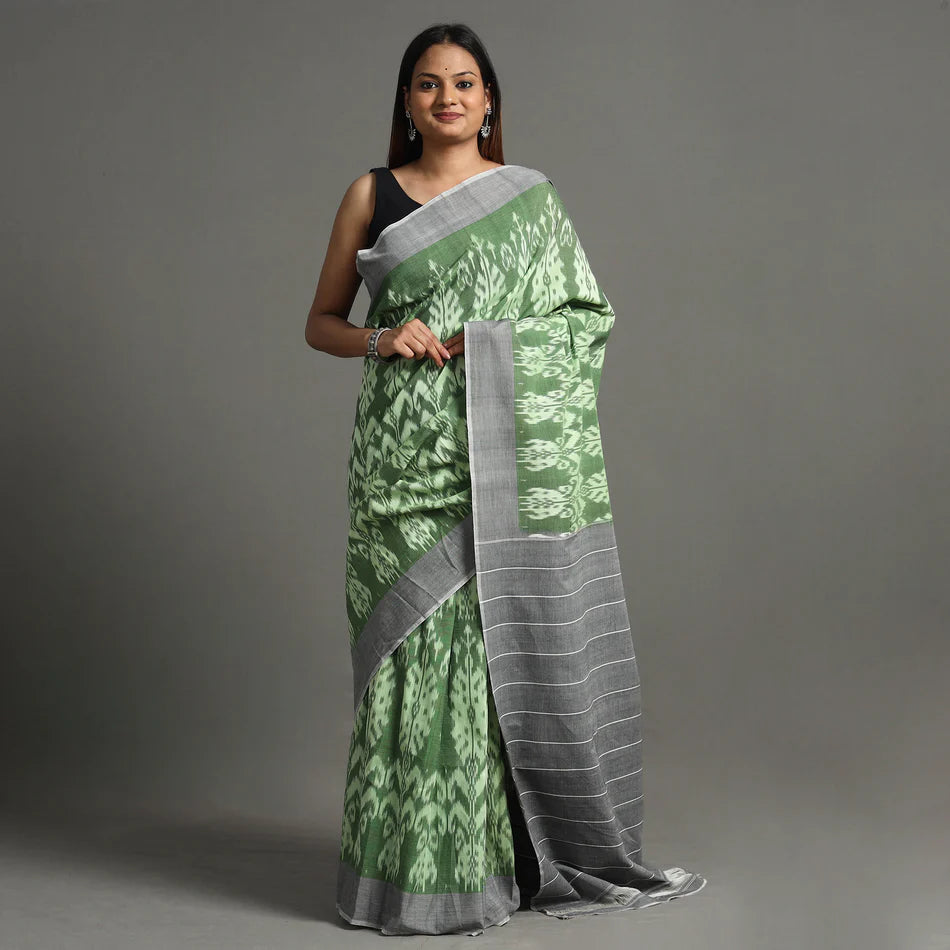
Saktapur
Double-ikat saree woven in Sambalpur and other towns of the western hill region of Orissa. They are woven in a chequerboard pattern of red, white and black, named after the game. The bride and groom play the game after their marriage as part of the ceremony called ‘the wedding saree’.
Sambalpuri
Name given to ikat sarees woven in Sambalpur,
Sonepur, Butapali and such towns in the western hill regions of Orissa. They are woven in Tussar and mulberry silk, the latter becoming more popular with wearers outside Orissa. Other Orissa bandh sarees (loosely termed ‘Sambalpuri’) carry lines of rudraksha designs along the borders in white yarn.
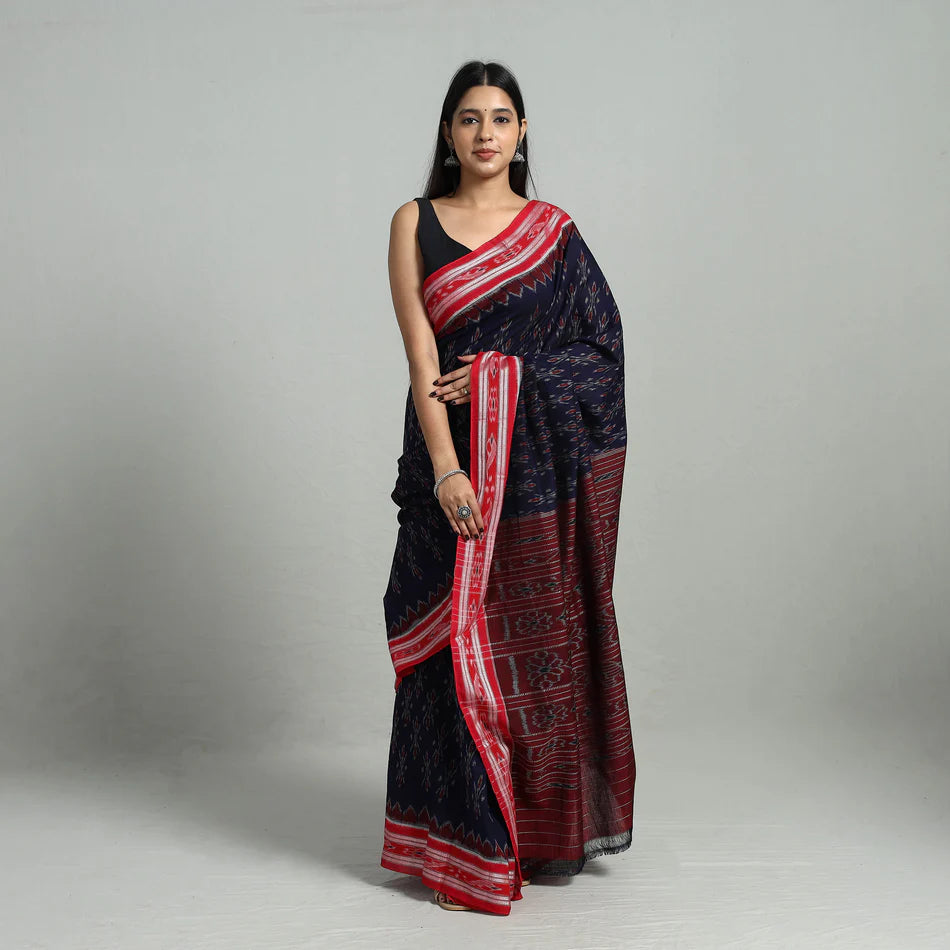
Vachitrapuri
From Sambalpur, in Orissa. Considered wedding sarees with a combination of bandha and woven patterns. The pallu usually is made up of weft bandha and woven squares or lines in silk.
Valkalam
One of the recent additions to Banaras's proud tradition of satin silk sarees. They are traditionally plain-bodied with rich woven borders and a spectacular pallu to match the borders. These are woven with extra weft in the style of brocades, though many keep to the subtle patterning of allied colours rather than too many startling combinations.
This content is originally posted at TEXTILES OF INDIA.
Blogs you might also like:
Sea Silk Seamstress
Styling Indian Ethnic Sarees
All you need to know about magnificient sarees of Odisha
 Verified Purchase
Verified Purchase








































































Esha
Liquid error (sections/custom_blog_posts line 652): The format option 'month_day_year' is not a supported format.
This was helpful!!